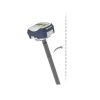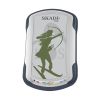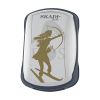Eos Skadi 200 RTK GNSS Receiver
Features
- Works with both SBAS and RTK networks
- Optional Skadi Tilt Compensation captures points quickly without having to level a survey range pole
- Compatible with Skadi Smart Handle for Invisible Range Pole and Extensible Virtual Range Pole features
- Free ground shipping
- Expedited repair and warranty service
- Lifetime technical support
- More
Overview
The Skadi 200 is the entry-level RTK-enabled GNSS receiver in the Skadi Series from Eos Positioning Systems. With support for dual-frequency on all GNSS constellations, the Skadi 200 lets you obtain reliable centimeter-level RTK accuracy in the field. The Skadi 200 is compatible with any existing RTK network, CORS network, and base station. It is also compatible with free SBAS signals in areas without RTK coverage, and it is device agnostic to work with any iOS, Android, or Windows mobile device.
In addition to the accuracy and performance you would expect from any Eos GNSS receiver, the Skadi 200 also includes several advanced mapping capabilities available only in the Skadi Series product line. These include an integrated antenna and hot-swap, all-day battery pack. Moreover, the Skadi 200 can be activated with the Skadi Tilt Compensation so you can remain more productive at every point by not having to level your physical range pole.
Finally, your included Skadi Standard Handle may be optionally upgraded to the Skadi Smart Handle to take advantage of two exciting features. First, the Invisible Range Pole provides continuous elevation measurements to the ground. Additionally, the Extensible Virtual Range Pole lets you remotely capture assets located a short distance away that are on the ground and in trenches.
Skadi Tilt Compensation
When you activate Skadi Tilt Compensation, you eliminate the need to level your antenna while performing RTK data collection on a range pole. With Skadi Tilt Compensation activated, you introduce only .3 mm (.01 inch) of inaccuracy per degree of tilt.
Skadi Smart Handle
The Skadi Smart Handle is a physical upgrade to your included Skadi Standard Handle. The smart handle features two exciting and powerful features. These features include the following:
Invisible Range Pole
The Invisible Range Pole is an innovative approach to bringing the benefits of a traditional survey range pole into your hand without the cumbersome physical weight. With the Invisible Range Pole feature, you carry a virtual gimbal that keeps you plumb to the ground. Raise, lower, or tilt the receiver, your elevation to the ground is continuously computed below the Skadi receiver in your hand, thanks to the exciting combination of LiDAR and MEMS technologies.
Extensible Virtual Range Pole
This exciting and innovative feature allows you to extend the reach of your data collection beyond the position you physically occupy. Using a built-in green laser pointer, now you can “shoot” short-distance assets on the ground while retaining high accuracy. This is particularly useful for assets in trenches and similar environments. The Extensible Virtual Range Pole has an approximate range of about seven meters (23 feet) in bright sunlight conditions (performance may vary based on target reflectivity).
- Skadi 200 GNSS Receiver with Integrated Antenna
- Pole Mounting Plate for Skadi Series
- Skadi Standard Handle (upgradable to Skadi Smart Handle)
- Phone Mounting Bracket for Skadi Series Handles
- Tablet Mounting Bracket for Skadi Series Handles
- Skadi Series Li-Ion Battery Pack
- USB-C Power Block
- USB-C Cable
- Skadi Series Hardshell Case
In The News
Source Water Monitoring in Albany, New York: Tracing Water Quality throughout Tributaries
Thousands of US cities pull their drinking water from natural source waters like reservoirs, rivers, and streams, making overall watershed health a key consideration for water providers. In Albany, New York, the Albany Department of Water and Water Supply delivers drinking water to over 100,000 residents as well as monitors and manages the larger drinking water supply watershed. Hannah Doherty, Environmental Specialist at the Albany Department of Water and Water Supply , spends her days working with a small team to monitor the drinking supply and the connected water bodies. Doherty explains, “We’re the first to encounter the water that ends up being the drinking water.
Read MoreWildfire Prevention in the Sierra Nevada Region with the Yuba Watershed Institute
Though recent wildfires have sparked new conversations about wildfire management and response, groups like the Yuba Watershed Institute have been monitoring the forests and water resources of the Sierra Nevada region for decades, managing approximately 5,000 acres of land with the Bureau of Land Management (BLM) and about 7,000 acres in private land partnerships. The goal of the Institute is to work with local communities and land agencies to improve watershed and forestry management through informed practices and public outreach. The goals of the Yuba Watershed Institute are three-fold: Improve the ability of fire suppression agencies like the California Department of Forestry and Fire Protection ( CAL FIRE ) and the US Forest Service.
Read MoreWave Sensors Integration with NexSens Buoys: A Cutting-Edge Solution for Wave Measurment
Real-time wave data supports accurate weather prediction, safe and efficient maritime operations, and provides valuable safety and operating condition information for recreation and commercial fishing. Understanding wave dynamics also helps with the design of protective coastal structures like seawalls, breakwaters, and jetties. It also supports better prediction of their impact on sediment transport and coastal geomorphology. Wave data is a key factor in qualifying and designing offshore wind farms and harnessing kinetic energy for electrical generation. It helps with the understanding of ocean-atmosphere interactions and contributes to studies of sea-level rise and climate change impacts.
Read More
































